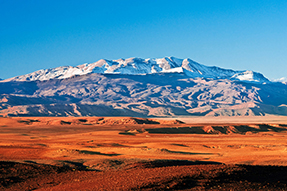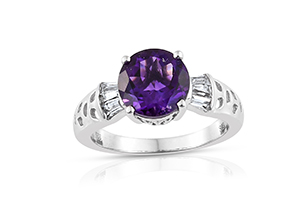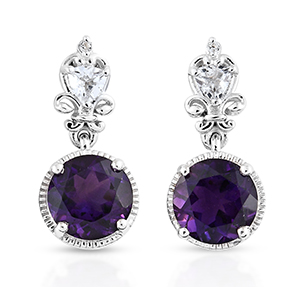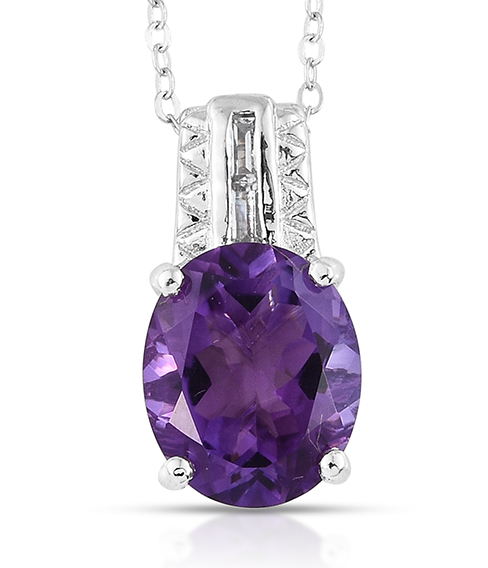MOROCCAN AMETHYST GEMSTONE
Moroccan amethyst beguiles us with intense flashes of red against a velvety purple backdrop. Perhaps you’ve seen a few amethyst crystals in your time, but never one like this! Carefully turning this specimen of Moroccan amethyst in your hands, you witness the characteristic flashes of red the stone is famous for. How did such a stone become one of the most desirable amethyst gems on the market today? Learn how to identify Moroccan amethyst and how to tell it apart from other amethyst gemstones.
What is Moroccan Amethyst Stone?
For over 20 years, small crystals of Moroccan amethyst have been entering the market as souvenirs for tourist. Only since the early 2010s have gem quality stones been widely available. Is Moroccan amethyst rare compared to other amethyst types? While amethyst is relatively common, and occurs in many areas around the world, only Moroccan amethyst possesses certain rare characteristics that make it unique.
Due to these unique properties, only one-percent of Moroccan amethyst is of gem-quality.
Determining Moroccan Amethyst Stone Value
The value of colored stones is typically determined by a combination of its color, clarity, cut, and carat weight. This is no different when determining what Moroccan amethyst is worth. These guidelines will help you choose Moroccan amethyst stones for your collection.
- Moroccan Amethyst Color
Like other varieties of amethyst, stones from Morocco exhibit a range of color potential, based on the quality of rough material used. It can range from a very light purple through a deep purplish red. Amethyst receives its color through trace amounts of iron.
Double-terminated crystals typically show the best color after cutting, producing a deep purple gemstone. Expect to see flashes of red dance across the surface as the gem catches the light. These rare crystals only account for two percent of all gem-quality production.
‘AAA’ grade Moroccan amethyst is also deep purple in color, but the potential for flashes of red is diminished. These stones are among the best value in Moroccan amethyst, providing the desirable deep purple color paired with an affordable price tag.
The most common grade in the market is ‘AA’ grade. Slightly less purple than ‘AAA’ Moroccan amethyst, this stone is widely found in many jewelry types due to its low price and availability. Anyone who loves purple will love this grade of stone.
The final grade of Moroccan amethyst is known as ‘Rose du Maroc.’ Much like its cousin, Rose de France amethyst, Rose du Maroc is a dainty pastel tone of purple. This grade of jewel is infrequently seen in Moroccan amethyst jewelry.
- Moroccan Amethyst Clarity
In general, many quartz gemstones are subject to color zoning. Color zoning is a phenomenon where the colored portion of the stone shows graduation of tone within the gem. Sometimes this is along a gradient, moving from light to dark through a crystal. At other times, it occurs as pools of color.
In Moroccan amethyst, color zoning happens in a unique ‘hourglass’ pattern. Pools of purple form toward the top and bottom of crystals, thinning at the center. Understandably, it is a challenge for cutters to shape, as traditional methods don’t leave much room for a significant yield. Yield from rough is less than ten-percent when using traditional methods.
Perhaps the most unique clarity characteristic of Moroccan amethyst is the jewel’s unique inclusions. Fine needles of hematite can be found within the stone. These create the unique flashes of red seen within. There is a direct correlation of hematite inclusions to depth of color. The stones with the deepest purple color are the most likely to have these hematite ‘fingers’ inside. Overall, only around 50-percent of Moroccan amethyst possesses this unique feature.
- Moroccan Amethyst Cut
You’ll find Moroccan amethyst in a variety of shapes that runs the gamut of popular styles. Traditional stone cuts only produce an eight-percent yield, further reducing the availability of this special stone.
- Moroccan Amethyst Carat
Though cutting Moroccan amethyst is complicated by its unique color-zoning properties, the stone is available in a pleasing variety of sizes. Shop LC offers Moroccan amethyst jewelry in sizes ranging from three-quarter carats to just over 15-carats. Most faceting material is between five to ten carats in size.
Moroccan Amethyst Treatment
This material undergoes no additional treatment. Sometimes, amethyst may undergo heating to improve its color when it is too dark. Moroccan amethyst already comes from the earth in an ideal color!
Who Can Wear Moroccan Amethyst?
Purple is a mystical and mysterious color. It is the color of royalty. Purples envelop us in their velvety hues and carry us with style. For centuries, amethyst gemstones were considered one of five precious stones, alongside diamond, sapphire, ruby, and emerald. Discovery of Brazilian deposits changed everything, making this a gem available to everyone.
You’ll find Moroccan amethyst jewelry in many styles, ranging from fashion jewelry and beyond. Amethyst is a versatile stone, making it popular for use in settings of sterling silver and finishes of precious platinum or brilliant gold.
How Does Moroccan Amethyst Compare to Other Amethyst Stones?
A gem’s source doesn’t always mean that it will consistently display a particular color or range. Moroccan amethyst is best known for its deep purples with flashes of red from hematite inclusions. Compared to other amethyst stones, such as Lusaka amethyst, you may find the same deep purples. However, the inclusions of hematite are unique to this stone.
Where Does Moroccan Amethyst Come From?
Shop LC sources our supply of Moroccan amethyst from Boudi, nestled in the Atlas Mountains of Southern Morocco. However, this jewel has only recently entered the world stage and become widely available.
Sometime in the early 1990s, a group of nomads was traveling through the mountains. A raging storm drove them to seek refuge from the elements. After weathering the raging tempest through the night, they emerged from their shelter the following morning. To their surprise, the rain had washed mysterious purple crystals to the ground. Considering them valuable, the nomads collected the crystals, hoping to trade them on their travels.
For decades, nomads continued collecting these crystals by hand, trading them to local villages to be bought as trinkets by tourists. Eventually, these unusual stones came to the attention of a geologist. In 2010, the purple crystals were analyzed by the Gemological Institute of America, confirming that they were indeed amethyst. Sensing an opportunity to bring these exciting stones to the public, the potential for mining the area entered discussions.

How is Moroccan Amethyst Mined?
The mining area in Boudi is mountainous, ranging in altitude between 870 and 1120 miles high. The climate is extremely arid, only accessible by a remote roadway followed by an unpaved road. These factors, combined with a lack of water and electricity make mining challenging.
Professional mining of the deposit began between 2011 to 2012. In accordance with Moroccan law, mining is carried out in open pits. Initially, miners were utilizing hand tools and artisanal methods for extracting the stone. As the deposit became mature, and demand increased, mining methods moved to mechanized methods starting in 2015. While excavators are used to move earth, workers continue to collect the crystals by hand.
Crystals are transported to a warehouse in Casablanca for cleaning and grading. High-pressure hoses are used to wash away any removing dirt from the rough stone. After, amethyst rough is washed in a solution of diluted hydrochloric acid. This mixture dissolves any remaining limestone that might be attached to the amethyst. Once fully clean, rough stone is then sorted into the four grades of Moroccan amethyst.
The Geostone Group, who supplies Shop LC with our source of Moroccan amethyst, commits to an ethical supply chain. They hire local Berbers to mine for the stone, providing workers competitive salaries and healthcare. In addition, Geostone Group funds improvements to local infrastructure, they help build the community around the mining area. Mine profits pay for roads, wells, electricity, and transportation.
Moroccan Amethyst Properties
Amethyst is a stone of protection and has long been appreciated by ancient cultures and gem therapists for its calming and purifying attributes. Some suggest that amethyst soothes troubled minds by providing a peaceful sleep. It’s also considered a talisman against evil magic and intoxication.
Ancient Egyptians would carve amethyst and other stones into protective amulets known as fetishes. These would take the shape of animals that are sacred to their culture, which the Ancient Egyptians believed would provide protection from physical and spiritual harm.
Early Christians viewed these same elements through the lens of Jesus Christ. For them, the color purple was synonymous with purity of spirit, and how suffering makes one pure. Others likened the reddish-purple color to Christ’s wounds, and believed the stone would aid in healing.
Disclaimer: For informational purposes only. These remedies, approaches, and techniques are not a substitute for professional medical care or treatment. They should not be used to treat any ailment without prior consultation with a qualified health care professional.
Is Moroccan Amethyst a Birthstone?
Amethyst is the modern birthstone for February. With a range of reddish-purple to bluish-purple gemstones, Moroccan amethyst is a welcome addition to this list. With the stone’s potential to create fascinating flashes of red, Moroccan amethyst birthstone jewelry is a unique spin on a classic gift.
Amethyst jewelry is also the traditional gift for the 6th wedding anniversary.
Moroccan Amethyst Facts
- Moroccan amethyst ranks seven on the Mohs hardness scale.
- Moroccan amethyst is famous for its lush purples, unique “hourglass” color zoning, and hematite inclusions that create fiery flashes of red within the stone.
- Shop LC sources Moroccan amethyst from Boudi, nestled in the Atlas Mountains of Southern Morocco.
- Moroccan Amethyst undergoes no additional treatment.
- How to Clean Moroccan Amethyst.
Moroccan Amethyst Gem Video
You’ve probably heard about Amethyst, hardly anyone has heard about Moroccan Amethyst. What makes it unique is the red hematite. The red needles it has inside. These make it unique and very special. This is currently the only amethyst in the world you can see the red flashes that were captured during the formation of the crystal. The pattern of these needles is completely different from one stone to another. This becomes a real fingerprint. When you look at one piece, it is one of a kind.
Here we are truly in the middle of nowhere but it's all worth it because of this bare landscape behind me is the only place on earth where this amethyst can be found. These mountains are very old, and this mountain region is the oldest at 2 billion years old. This one behind me contains a collision of three very rare geological events. Now two of these ecological events anywhere else on earth would be something special. But three geological events is unheard of, and that’s why it can’t be found anywhere else on the planet.
You know people when they hear amethyst they think geodes, this is how they think amethyst is made. But this Moroccan amethyst is made from loose stones, and we don’t mine a big chunk of stones. You have to collect them piece by piece, one by one, and this is how Mother Natures brings them up to us.
We take the rock, and we disregard almost all of it to get the quartz, and out of quartz, we disregard almost 95% to get the amethyst, and out of the amethyst, we only keep 5% that would be gem quality. We spend days and days and to only come up with a few pieces of crystal that would yield to the pieces of jewelry you are going to see today.,
To get to one piece of Moroccan amethyst fro 5 carats we have to mine one to one and a half tons of earth. That is what it takes to get one piece of Moroccan amethyst. So it’s a rare, rare, rare amethyst in the world.
The true story of Moroccan amethyst starts right here in the middle of nowhere. Two Nomads got caught in an epic rainstorm. When the storm subsided, they discovered that the ground was glowing with this beautiful purple glows and they went to gather them up, and they said these are crystals. These are beautiful crystals. They took them to the market and sold them to tourists for years. A year later a geologist got involved and sent some samples to the GIA. They said this some of the most beautiful amethyst we’ve ever seen. Today that is Morrocan Amethyst only found one place on earth right here.
It’s been an incredible journey that has taken us to the edge of the Sahara. Remember when you look at your Moroccan amethyst it comes from one place on earth. From a mountain region over 2 billion years old in the middle of nowhere. Each piece is unique. Which means no matter where you go in the world you will never find anything like Moroccan Amethyst.







